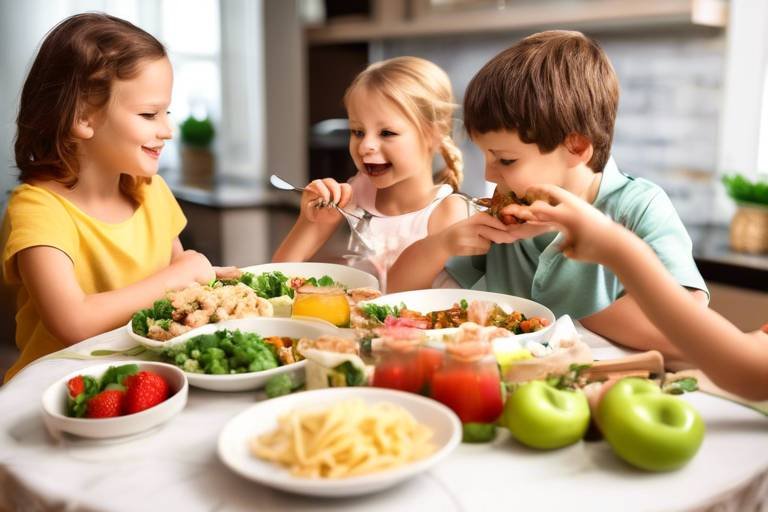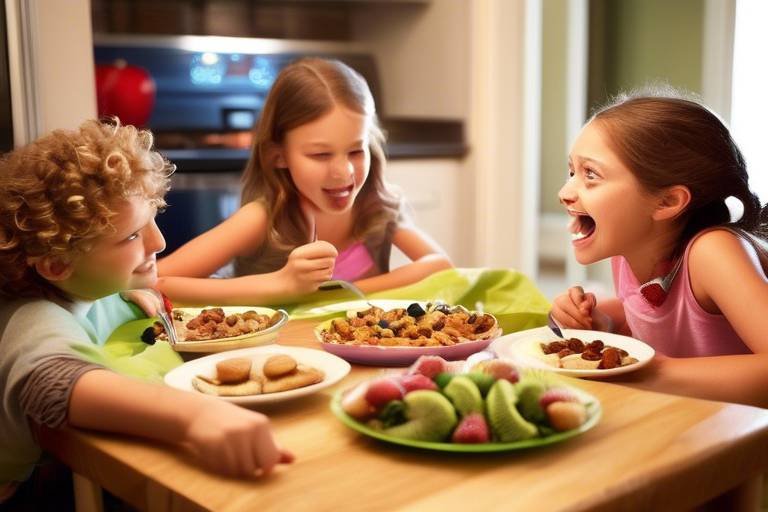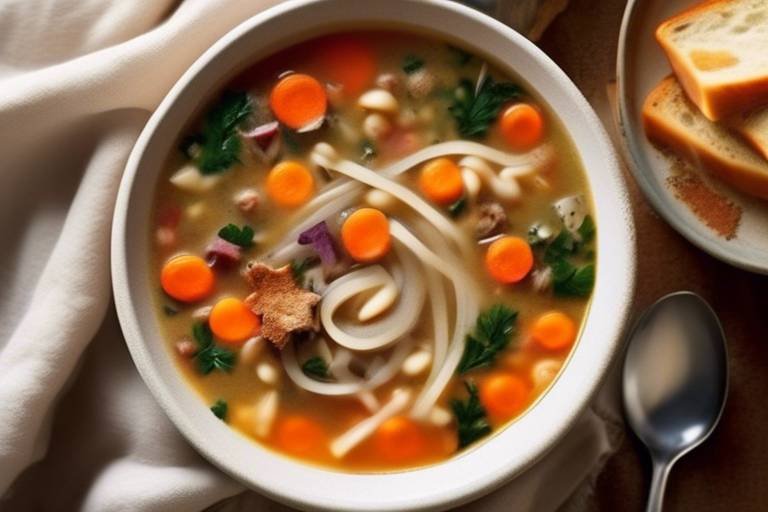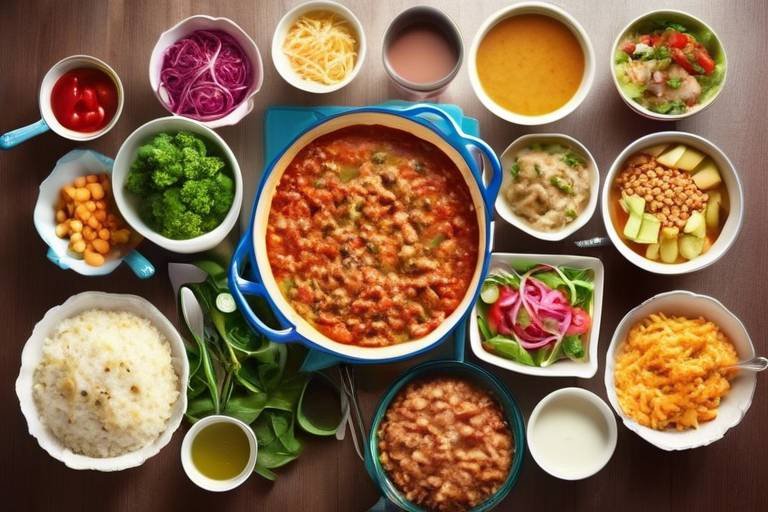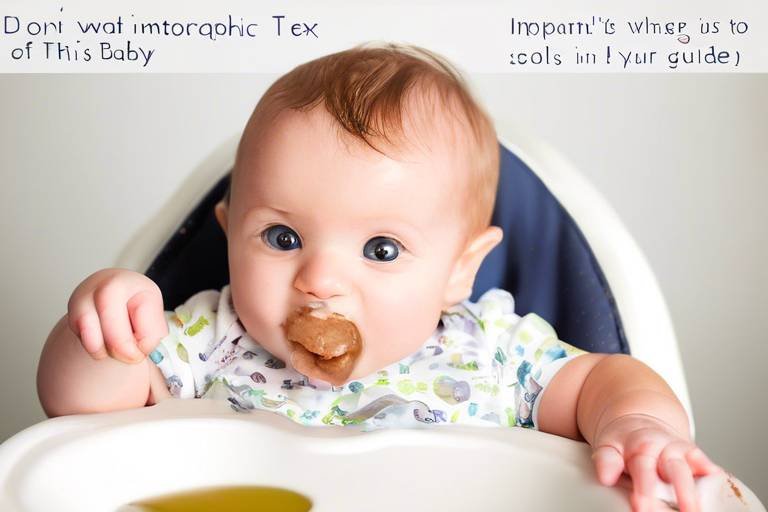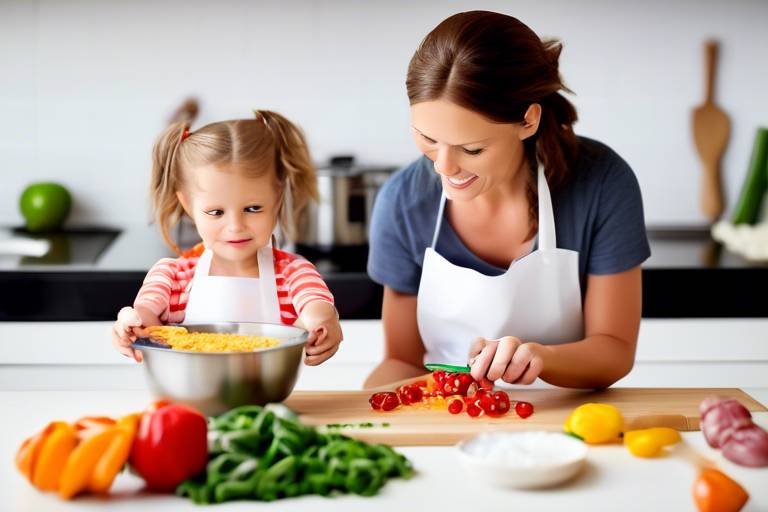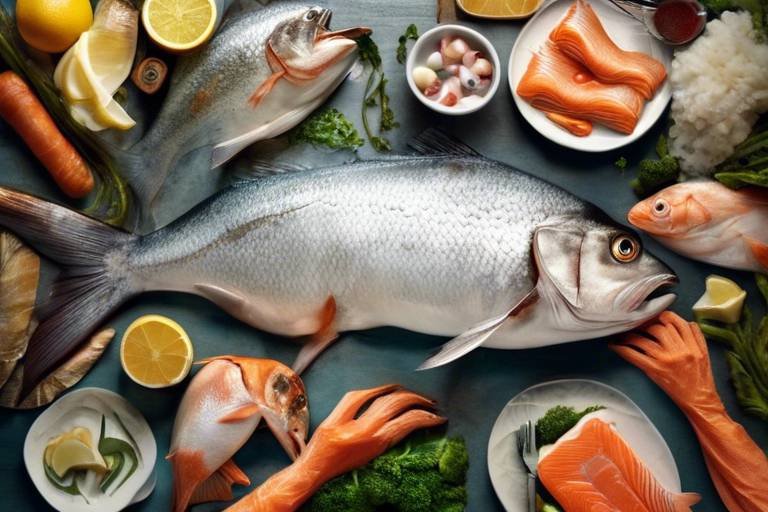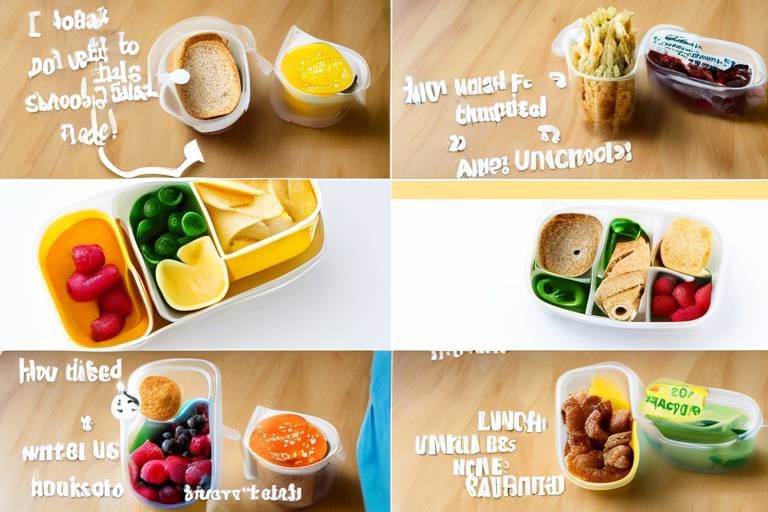How to Make Meals Fun for Your Kids
Mealtime can often turn into a battleground, with parents struggling to get their kids to eat healthy foods. But what if we could transform that struggle into a delightful experience? Imagine a world where your children eagerly anticipate meals, their plates filled with colorful, fun, and nutritious food. Making meals fun for kids is not just about the food; it's about creating an atmosphere that sparks joy and curiosity. By incorporating creative ideas and strategies, you can turn every meal into an adventure that encourages your little ones to eat healthy while having a blast!
One of the simplest ways to make mealtime exciting is by incorporating engaging meal themes. Think of it as a mini-adventure right in your dining room! You can take your children on a culinary journey, whether it’s a pirate feast complete with treasure maps or a space-themed dinner where they can explore the galaxy of flavors. Themed meals ignite imagination and make dining an imaginative experience. For instance, you could serve “alien” green foods on a “planet” of mashed potatoes, or have a “treasure hunt” where kids find hidden veggies in their dishes. The possibilities are endless!
Another fantastic way to engage your kids is through interactive cooking activities. When children participate in the cooking process, they are more likely to enjoy the food they help prepare. Simple tasks like washing vegetables, stirring sauces, or assembling their meals can create lasting memories. Not only does this foster a love for food, but it also teaches them essential life skills. You might be surprised at how much they enjoy getting their hands dirty in the kitchen!
One of the most popular interactive cooking activities is hosting a DIY pizza night. Kids love the idea of making their own pizzas, choosing from a variety of toppings to create their culinary masterpieces. This hands-on activity not only promotes creativity but also allows children to express their personal preferences in food choices. You can set up a pizza-making station with a range of ingredients, from classic tomato sauce and mozzarella to unique toppings like pineapple or spinach. It's a delicious way to encourage them to try new flavors!
While kids are busy crafting their pizzas, take the opportunity to introduce a variety of healthy toppings. Include a colorful selection of vegetables, lean proteins, and even some herbs. Explain the benefits of each topping, encouraging children to experiment with flavors and textures. For example, let them know that spinach is packed with iron, while bell peppers are rich in vitamin C. This not only makes the meal healthier but also educates them about nutrition in a fun way!
To add an extra layer of fun, consider using cookie cutters to shape pizza dough into exciting designs. Creative pizza shapes can make the meal visually appealing, turning an ordinary pizza into a star, heart, or even animal shapes. Kids are naturally drawn to fun visuals, and this simple trick can encourage them to eat what they’ve made. Plus, it’s a great way to get them involved in the kitchen while having a laugh!
Presentation is key when it comes to making meals exciting for kids. Fun food presentation can stimulate interest and appetite. Use colorful plates, arrange food in whimsical shapes, or create food art with fruits and vegetables. For instance, you could turn a simple fruit salad into a rainbow by arranging the fruits in layers or creating a smiling face with yogurt and berries. When meals look appealing, kids are more likely to dive right in!
While making meals fun, don’t forget to incorporate educational elements. Teaching kids about nutrition while preparing meals can be incredibly beneficial. Discuss the benefits of different foods and how they contribute to a healthy lifestyle. This enhances their understanding and appreciation of what they eat, making them more likely to choose healthy options in the future.
Explaining where foods come from and their nutritional value can make children more curious and engaged about their meals. For instance, you could talk about how broccoli grows in the ground and is a fantastic source of vitamins. Such conversations can spark interest and lead to a deeper understanding of food and health.
Finally, exploring international cuisines can introduce children to diverse flavors and cultures. Cooking around the world can turn mealtime into an educational adventure that broadens their culinary horizons. Try making tacos one night, sushi the next, or even a classic Italian pasta dish. Each meal can be a journey to a different country, allowing your kids to learn about various cultures while enjoying delicious food!
- How can I encourage my picky eater to try new foods? - Involve them in the cooking process and let them choose toppings or ingredients.
- What are some simple meal themes I can try? - Themes like "Under the Sea," "Superheroes," or "Fairy Tales" can be fun and engaging!
- How important is food presentation for kids? - Very important! Fun presentations can make meals more appealing and exciting for children.

Engaging Meal Themes
Transforming mealtime into a thrilling adventure is easier than you might think! can spark excitement and make dining an imaginative experience for your little ones. Imagine a dinner table that doubles as a pirate ship, sailing the high seas of flavor, or a cozy lunar landscape where your kids can feast like astronauts. By incorporating themes into meals, you not only make eating fun but also encourage creativity and exploration in your children's culinary journey.
One fantastic way to kick off this thematic adventure is by choosing a weekly theme. For instance, you could have a "Taco Tuesday" where kids can dress their tacos with all sorts of toppings, or a "World Cuisine Wednesday" featuring dishes from different countries. The possibilities are endless! You can even create a
| Day | Theme | Dish Ideas |
|---|---|---|
| Monday | Italian Night | Pasta, Pizza, Bruschetta |
| Tuesday | Taco Tuesday | Soft Tacos, Hard Shells, Nachos |
| Wednesday | World Cuisine | Sushi, Curry, Tacos |
| Thursday | Breakfast for Dinner | Pancakes, Omelets, Smoothies |
| Friday | Fun Finger Foods | Sliders, Veggie Sticks, Dips |
As you can see, having a structured theme not only provides variety but also helps kids anticipate what’s coming next, adding an element of excitement to each meal. Encourage your children to participate in the planning process; let them choose the themes or dishes they want to try. This involvement can lead to greater enthusiasm and willingness to try new foods.
Additionally, consider incorporating storytelling into your meal themes. For instance, while enjoying a "Dinosaur Dinner," you could read a fun dinosaur fact or tell a story about a dinosaur that loved to eat broccoli. This not only makes the meal more enjoyable but also helps to create a memorable experience that your kids will cherish. The key is to make mealtime a shared adventure, where everyone is excited to explore new flavors and culinary creations together.
In conclusion, engaging meal themes can turn every dinner into an exciting event. By creatively incorporating themes, involving your children in the planning and cooking, and even adding storytelling elements, you can create an environment that encourages healthy eating habits while making mealtime a delightful experience. So, what theme will you choose for your next family dinner?

Interactive Cooking Activities
Getting your kids involved in the kitchen can turn meal preparation into a delightful adventure! Imagine the joy on their faces as they become little chefs, stirring, mixing, and creating dishes that they'll be excited to eat. This hands-on experience not only fosters a love for food but also teaches them valuable life skills. When children participate in the cooking process, they gain a sense of accomplishment and ownership over their meals, which can lead to healthier eating habits. So, how can you make cooking more interactive for your kids? Let's explore some engaging activities that will keep them entertained and eager to help out!
One of the most fun and interactive cooking activities is hosting a DIY pizza night. Kids love pizza, and allowing them to create their own masterpieces can be a delightful experience. You can set up a pizza-making station with various toppings laid out, giving them the freedom to choose what they want to include. This hands-on activity not only promotes creativity but also encourages kids to take charge of their food choices. They can experiment with different combinations, learning about flavors and textures in the process. Plus, it’s a fantastic way to sneak in some healthy ingredients!
When it comes to toppings, why not introduce a variety of healthy options? Consider setting out a colorful array of vegetables like bell peppers, spinach, and mushrooms, along with lean proteins such as grilled chicken or turkey. Encourage your children to try new flavors and textures by mixing and matching toppings. Not only does this make the meal healthier, but it also opens up discussions about nutrition. You can explain the benefits of each ingredient, making it a fun and educational experience. Who knew that a simple pizza night could become a lesson in healthy eating?
Another exciting way to make pizza night even more enjoyable is by using cookie cutters to shape the pizza dough into fun designs. Instead of the usual round pizza, you can create star-shaped, heart-shaped, or even animal-shaped pizzas! This visual appeal can stimulate interest and make the meal more exciting. Kids are more likely to eat what they’ve made, especially when it looks fun and inviting. Plus, it’s a great opportunity for you to show off your creativity as well!
Incorporating interactive cooking activities into your family routine can transform mealtime from a mundane task into a fun-filled experience. Not only do these activities engage your children and teach them about healthy eating, but they also create lasting memories that your family will cherish. So, roll up your sleeves, put on those aprons, and get ready for some kitchen fun!
- How can I encourage my kids to eat healthier? Involve them in meal preparation and allow them to choose healthy ingredients.
- What are some fun cooking activities for kids? DIY pizza night, cookie decorating, and making homemade smoothies are great options!
- How do I make cooking educational for my children? Discuss the nutritional value of ingredients and explore food origins while cooking.

DIY Pizza Night
Imagine this: it's a Friday night, the week has been long, and the kids are buzzing with energy. What better way to channel that energy than with a ? This fun-filled evening not only brings the family together but also allows your little ones to unleash their inner chefs. You can set the stage for a memorable culinary adventure right in your kitchen, turning an ordinary meal into an extraordinary experience. By giving your kids the reins to create their own pizzas, you’re not just serving dinner; you’re fostering a sense of creativity and ownership over their food choices.
To kick off your DIY Pizza Night, start by gathering all the necessary ingredients. You can have a variety of bases, such as traditional pizza dough, whole wheat crust, or even cauliflower crust for a healthier twist. Lay out an array of toppings that cater to different tastes and dietary preferences. Think of colorful vegetables like bell peppers, tomatoes, and spinach, alongside proteins such as grilled chicken, turkey pepperoni, or even plant-based alternatives. The more options you provide, the more excited your kids will be to mix and match!
As the kids dive into the pizza-making process, they can learn about the importance of each ingredient. For example, you might explain how tomatoes are rich in vitamins and antioxidants, or how whole grains can provide lasting energy. This educational component transforms cooking into a fun learning experience, making them more aware of what they are putting into their bodies. Plus, it’s a fantastic way to sneak in some nutrition lessons without them even realizing it!
Don’t forget about the fun shapes and presentations! Using cookie cutters to create fun designs with the pizza dough can add an extra layer of excitement. Imagine a star-shaped pizza topped with vibrant veggies or a heart-shaped pie filled with their favorite ingredients. These creative shapes not only make the meal more visually appealing but also encourage kids to eat what they’ve made. It’s like turning dinner into an art project!
Finally, as the pizzas come out of the oven, gather around the table and admire the colorful creations. Each pizza is a masterpiece, reflecting the unique tastes and personalities of your children. This communal aspect of DIY Pizza Night encourages family bonding and gives everyone a chance to share their culinary creations. You might even want to host a “pizza contest” where everyone can vote for their favorite pie, adding a playful competitive spirit to the night!
At the end of the evening, not only will your kids have had a blast making their own pizzas, but they will also have developed a greater appreciation for cooking and healthy eating. So, why not make DIY Pizza Night a regular occurrence? It’s a simple way to bring joy to mealtime while teaching valuable lessons about food and nutrition!
Q: What if my kids are picky eaters?
A: Encourage them to try new toppings by introducing a “mystery topping” challenge where they have to taste something unfamiliar. You can also let them choose their favorite toppings to make them feel more involved.
Q: Can we make pizza dough from scratch?
A: Absolutely! Making pizza dough from scratch can be a fun activity in itself. Just combine flour, water, yeast, and a pinch of salt, and let the kids help with the mixing and kneading.
Q: How can I make the pizza healthier?
A: Opt for whole wheat crusts, use low-fat cheese, and load up on veggies. You can also offer a variety of healthy sauces, like pesto or homemade tomato sauce, to enhance the flavor without extra calories.

Healthy Toppings Exploration
When it comes to making meals fun for kids, one of the most exciting ways to do so is through the exploration of healthy toppings. Imagine this: your little one is standing in the kitchen, eyes wide with wonder, as they gaze upon a colorful array of toppings laid out before them. This isn't just any meal; it’s a canvas for their creativity! By allowing kids to choose from a variety of toppings, you not only spark their interest but also encourage them to embrace healthier options.
From vibrant vegetables to lean proteins, the options are endless. Picture a table filled with fresh bell peppers, cherry tomatoes, spinach, and mushrooms, all chopped and ready to go. These ingredients are not only nutritious but also visually appealing, making them perfect for enticing young eaters. You can even add a splash of fun by introducing toppings like pineapple chunks or grated cheese, which can serve as a delightful surprise!
One of the best parts about this exploration is the opportunity for taste testing. Encourage your kids to try a little of everything. You could say, "How about we make a mini pizza with a mix of spinach and pineapple? Let’s see if it’s a flavor explosion!" This kind of interaction not only makes mealtime engaging but also teaches them about balancing flavors and textures.
Moreover, you can turn this into a fun educational experience. Discuss the health benefits of each topping. For instance, you might explain how spinach is packed with iron, which is great for energy, or how bell peppers are rich in vitamin C, which helps keep their immune system strong. This knowledge can empower them to make healthier choices not just at home but also when they’re out with friends.
To make it even more interactive, you could create a simple chart that showcases different toppings and their nutritional benefits. For example:
| Topping | Benefits |
|---|---|
| Spinach | High in iron and vitamins A and C |
| Bell Peppers | Rich in antioxidants and vitamin C |
| Pineapple | Contains bromelain, which aids digestion |
| Mushrooms | Good source of B vitamins and selenium |
By providing this kind of information, you're not just encouraging them to eat healthier; you're also nurturing their curiosity about food and nutrition. In the end, the goal is to create a positive association with healthy eating that lasts a lifetime. So, roll up those sleeves, gather those toppings, and let the exploration begin!
- What are some fun ways to encourage kids to try new toppings? Try hosting a "topping party" where kids can mix and match different ingredients to create their own dishes.
- How can I make healthy toppings more appealing? Use colorful plates and arrange toppings in fun shapes to make them visually enticing.
- Are there any toppings I should avoid? It's best to limit processed toppings high in sugar and sodium. Focus on fresh, whole ingredients instead.

Creative Pizza Shapes
When it comes to making pizza night a hit, creative shapes can take the experience to a whole new level! Imagine a table filled with pizzas shaped like stars, hearts, or even dinosaurs. Not only does this make the meal visually appealing, but it also sparks the imagination of your little chefs. Using cookie cutters, you can easily transform regular pizza dough into fun shapes that will have your kids excited to eat their creations. Why not turn dinner into a playful adventure?
To get started, simply roll out your pizza dough and gather some cookie cutters in various shapes. Here are a few ideas to inspire you:
- Animals: Create pizzas shaped like their favorite animals—think bunnies, fish, or even unicorns!
- Seasonal Themes: For holidays, consider making pumpkin-shaped pizzas for Halloween or heart-shaped ones for Valentine's Day.
- Superheroes: Use shapes that represent their favorite superheroes or characters, making mealtime a superhero mission!
Once the dough is cut into fun shapes, let your kids unleash their creativity by adding toppings. The excitement of choosing their own ingredients can make them more willing to try new flavors. You can even create a "topping bar" where they can pick from a variety of healthy options, turning the meal into a mini culinary exploration.
Additionally, the way you present these pizzas can add to the fun! Consider using colorful plates or arranging the pizzas in a way that tells a story. For instance, you could create a pizza garden with veggie toppings that look like flowers or a pizza ocean with blue cheese and fish-shaped toppings. This not only makes the meal more engaging but also encourages your kids to eat their veggies without a fuss!
Incorporating into your meal planning is not just about food; it's about creating memories. Each bite becomes an adventure, and your kids will cherish these moments long after the meal is over. So, roll up your sleeves, grab those cookie cutters, and let the pizza-making fun begin!
Q: Can I use store-bought pizza dough?
A: Absolutely! Store-bought dough is a great time-saver and still allows for creativity. Just roll it out and start cutting!
Q: What if I don't have cookie cutters?
A: No problem! You can use a knife to cut out shapes or even make large, freeform pizzas that look like your kids' favorite characters.
Q: How can I encourage my kids to try new toppings?
A: Make it a fun challenge! Turn it into a game where they have to try at least one new topping each time they make a pizza.

Fun Food Presentation
When it comes to making meals fun for kids, presentation is key. Imagine sitting down to a plate of food that looks like a work of art rather than just another dinner. Kids are naturally drawn to colorful, visually appealing meals, and by putting a little creativity into how you serve food, you can turn an ordinary meal into an extraordinary experience. Think of it as a culinary canvas where the plate is your palette. For instance, arranging fruits and vegetables in the shape of animals or using cookie cutters to create fun shapes can spark excitement and curiosity at the dinner table.
One effective way to enhance food presentation is by using colorful plates. Bright, vibrant dishes can make even the simplest meals look exciting. You might want to consider using plates with fun designs or colors that appeal to children. Additionally, you can create a food rainbow by incorporating a variety of colorful fruits and vegetables into each meal. This not only makes the plate visually appealing but also ensures that your kids are getting a range of nutrients. You can even challenge them to eat a “rainbow” of foods throughout the week!
Another engaging technique is to play with the arrangement of food. Instead of just plopping everything on the plate in a haphazard way, think about how you can make it more fun. For example, you could stack pancakes to make a “pancake tower” or create a “food face” using different ingredients. A slice of banana for a smile, blueberries for eyes, and a sprinkle of granola for hair can turn breakfast into a delightful activity. The more imaginative the presentation, the more likely your kids will be excited to dig in.
Furthermore, you can introduce themed meals that align with holidays, seasons, or even their favorite movies. For instance, during Halloween, you might create spooky snacks like ghost-shaped sandwiches or pumpkin-shaped fruit salads. This not only makes the meal fun but also engages their creativity and imagination. You could even have a little competition where everyone gets to decorate their plate, and then you can choose a “winner” for the most creative presentation!
Ultimately, the goal is to make mealtime an engaging and enjoyable experience for your kids. By focusing on fun food presentation, you can encourage them to be more adventurous eaters and create lasting memories around the dinner table. Remember, the more fun they have with their food, the more likely they are to try new things and develop a love for healthy eating!
- How can I encourage my kids to eat healthy foods?
Involving them in the cooking process and making meals visually appealing can encourage healthier eating habits. - What are some fun themes for meals?
Consider themes like “Under the Sea,” “Space Adventure,” or “Superhero Dinner” to make mealtime exciting! - How can I make vegetables more appealing to my kids?
Try arranging them in fun shapes or pairing them with dips to make them more enticing.

Incorporating Educational Elements
When it comes to making mealtime not just enjoyable but also educational, the possibilities are as vast as the universe! One of the most effective ways to achieve this is by intertwining lessons about nutrition and food origins into your cooking sessions. Imagine the excitement on your child's face when they learn that the tomatoes they’re chopping for their homemade sauce are actually fruits, or that the broccoli on their plate is packed with vitamins that help them grow strong. By explaining the nutritional benefits of various ingredients, you can turn a simple meal into a fun and informative experience.
Consider discussing the origins of food, too. Where does rice come from? How does it grow? Kids are naturally curious, and answering these questions can ignite their interest in food and where it comes from. You might even create a fun little game where they guess the origin of different foods! This not only makes them more mindful about what they’re eating but also enhances their understanding of global cultures.
To take it a step further, why not embark on a culinary journey around the world? Each week, you could pick a different country and explore its traditional dishes. This is a fantastic way to introduce your kids to diverse flavors and cooking styles. For instance, you could have an Italian night with homemade pasta, followed by a Mexican fiesta featuring tacos. The world is a buffet of learning opportunities!
Here’s a simple table to illustrate how you might organize your international cooking nights:
| Country | Dishes to Try | Fun Facts |
|---|---|---|
| Italy | Pizza, Pasta | Did you know that pizza was invented in Naples? |
| Mexico | Tacos, Enchiladas | Mexican cuisine is recognized by UNESCO as an Intangible Cultural Heritage! |
| Japan | Sushi, Ramen | Sushi originated as a method of preserving fish in fermented rice. |
By incorporating these educational elements into mealtime, you’re not just feeding your child; you’re nourishing their minds as well. Who knew that cooking could be such a rich learning experience? So, roll up your sleeves and get ready to explore the world of food together!
- How can I make my kids interested in cooking?
Start with simple recipes and let them choose their favorite dishes. The more involved they are, the more excited they'll be! - What are some fun educational games to play while cooking?
You can play guessing games about the origins of ingredients or create a food trivia challenge. - How can I encourage my kids to try new foods?
Involve them in the cooking process and make it a fun adventure to explore new flavors together.

Food Origins and Nutrition
Understanding the origins of food is like embarking on a treasure hunt that leads straight to our plates. When kids learn about where their food comes from, it can ignite a spark of curiosity that transforms mealtime into an adventure. Imagine sitting down with your children and saying, "Did you know that the tomatoes on your pizza traveled all the way from sunny California?" This kind of storytelling not only makes the meal more interesting but also instills a deeper appreciation for the food they eat.
By incorporating discussions about nutrition into cooking, you can help your children grasp the importance of eating a balanced diet. For instance, when preparing a meal, you might explain how carrots are not just crunchy and sweet but also packed with vitamins that are great for their eyesight. This knowledge can empower them to make healthier choices, as they start to connect the dots between the food they eat and how it affects their bodies.
To make this learning experience even more engaging, consider creating a simple chart that outlines various foods alongside their origins and nutritional benefits. Here’s a quick example:
| Food | Origin | Nutritional Benefits |
|---|---|---|
| Carrots | Middle East | Rich in Vitamin A, good for eyesight |
| Tomatoes | South America | High in antioxidants, supports heart health |
| Spinach | Persia | Loaded with iron, great for energy |
Encouraging children to ask questions about their food can lead to fascinating discussions. Why not ask them, "What do you think is the most interesting food in the world?" or "If you could grow any vegetable, what would it be?" These conversations can turn into a fun exploration of different cultures and cuisines, making meals not just about eating but about learning and discovery.
Moreover, cooking around the world can be a fantastic way to introduce your kids to international flavors. For instance, you could plan a week where each day features a dish from a different country. One day could be Italian with pasta, another could be Mexican with tacos, and yet another could be Japanese with sushi. This not only diversifies their palate but also teaches them about global cultures, making them more open-minded and adventurous eaters.
In conclusion, by exploring the origins of food and discussing its nutritional value, you are not just filling their bellies; you are nourishing their minds. This approach can transform mealtime from a mundane routine into an exciting educational experience that fosters a lifelong love for healthy eating.
- Why is it important for kids to know where their food comes from? Understanding food origins can help children appreciate their meals and make healthier choices.
- How can I make learning about nutrition fun for my kids? Use stories, charts, and interactive cooking sessions to engage their curiosity.
- What are some simple ways to introduce international cuisines at home? Plan themed dinners, cook recipes from different countries, and discuss the cultural significance of the dishes.

Cooking Around the World
Exploring international cuisines is like taking a culinary trip without ever leaving your kitchen! Imagine the excitement on your child's face as they dive into the flavors of Italy, Mexico, or Japan. Cooking around the world not only introduces children to a variety of tastes but also opens the door to different cultures, making mealtime an adventurous experience. Have you ever thought about how much fun it would be to create a global feast right at home?
One of the best ways to engage kids in this journey is by selecting a country each week and dedicating that time to cook a traditional dish together. For example, you could whip up spaghetti from Italy, tacos from Mexico, or sushi from Japan. As you prepare these dishes, share interesting facts about the country’s culture, customs, and the significance of the food. This not only makes the cooking process interactive but also enriches their understanding of the world.
To make it even more engaging, consider creating a world map in your kitchen where you can pin the countries you've "visited" through cooking. Each time you try a new dish, mark it on the map. This visual representation will not only excite your kids but also instill a sense of achievement. Plus, it can spark conversations about geography, history, and even language!
Here are a few ideas to get you started on your culinary journey:
- Italian Night: Make homemade pizza or pasta, and teach your kids about the different regions of Italy.
- Mexican Fiesta: Prepare tacos or enchiladas, and talk about the vibrant culture and festivals in Mexico.
- Japanese Cuisine: Try making sushi rolls together and discuss the importance of sushi in Japanese culture.
As you embark on this global cooking adventure, encourage your kids to participate actively. Let them choose the recipes, help with shopping for ingredients, and even set the table with themed decorations that reflect the country's culture. By making them a part of the process, you're not just teaching them how to cook; you're also instilling a sense of curiosity and appreciation for different cultures and cuisines.
Incorporating these global meals into your routine can also lead to some surprising discoveries. Your child might find that they love spicy food from India or enjoy the sweetness of baklava from Greece. These experiences can help them develop a more adventurous palate and a love for trying new things, which is invaluable as they grow.
In conclusion, cooking around the world is more than just preparing meals; it's about creating lasting memories, fostering a love for food, and expanding your child's horizons. So, grab your cooking utensils and passport—it's time to embark on a delicious journey!
Q: How can I make cooking around the world more fun for my kids?
A: You can make it fun by allowing your kids to choose the countries or dishes they want to explore. Incorporate themed decorations and music from the culture to create an immersive experience!
Q: What if my child is a picky eater?
A: Start with familiar flavors and gradually introduce new ingredients. Make the cooking process interactive, allowing them to customize their meals, which can help them feel more comfortable trying new foods.
Q: How often should we try new cuisines?
A: Aim for once a week or bi-weekly to keep it exciting without overwhelming your schedule. This way, it becomes a fun tradition rather than a chore!
Frequently Asked Questions
- How can I make meals more exciting for my kids?
Transforming mealtime into a fun experience can be as simple as incorporating themed meals. Whether it's a pirate adventure or a space exploration, adding a theme can spark excitement and make dining an imaginative experience.
- What are some interactive cooking activities I can do with my kids?
Engaging your children in the cooking process is a great way to foster their love for food. Simple tasks like stirring, assembling ingredients, or even having a DIY pizza night where they can choose their toppings can create lasting memories while promoting healthy eating habits.
- How can I encourage my kids to try healthy toppings on their pizzas?
Introduce a variety of healthy toppings, such as colorful vegetables and lean proteins. By allowing them to create their own custom pizzas, they can explore new flavors in a fun way, making healthy choices more appealing.
- What’s the best way to present food to make it visually appealing?
Presentation is key! Use colorful plates and arrange food in fun shapes. You can even use cookie cutters to shape pizza dough into exciting designs. This not only makes the meal visually appealing but also encourages kids to eat what they've made.
- How can I incorporate educational elements into mealtime?
While cooking, take the opportunity to teach your kids about nutrition and the origins of different foods. Discussing the benefits of various ingredients can enhance their understanding and appreciation of healthy eating.
- What are some ways to explore international cuisines with my kids?
Cooking around the world can be a fun adventure! Choose a country and prepare traditional dishes together. This not only introduces them to diverse flavors but also broadens their culinary horizons and cultural understanding.


